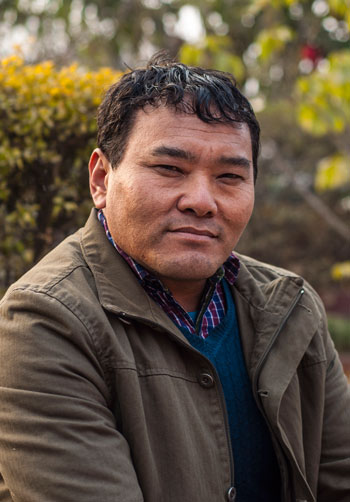Many are the mountains he has summited, many are the trails he has trekked, yet he keeps trudging ever onwards, and climbing ever higher.
 Reflecting back on his childhood, he says that climbing mountains had always been his dream. From a distance, he would admire the shining white snow of the mountains towering over all else. People from his village Okhaldhunga, though, would tell him that climbing mountains was a far-fetched dream. Little did they know that this young dreamer would grow up to summit Everest four times, and become the second vice-president of the Nepal Mountaineering Instructors Association. Here is an excerpt of my chat with the 41-year-old mountaineer Lakpa Sherpa.
Reflecting back on his childhood, he says that climbing mountains had always been his dream. From a distance, he would admire the shining white snow of the mountains towering over all else. People from his village Okhaldhunga, though, would tell him that climbing mountains was a far-fetched dream. Little did they know that this young dreamer would grow up to summit Everest four times, and become the second vice-president of the Nepal Mountaineering Instructors Association. Here is an excerpt of my chat with the 41-year-old mountaineer Lakpa Sherpa.
 How did you become a mountaineer?
How did you become a mountaineer?
Initially, I indulged in trekking. I first started getting trained for mountaineering in 1998 at Nepal Mountaineering Association. In 2002, the association selected its top three students to send to a scholarship program in France, and I was one of them.
How was the training in France?
I spent fruitful days with ENSA (National School of Ski and Alpinism). They had excellent facilities and I could learn a lot there.
Can you recall some of your important climbs?
The first mountain I summitted was Ama Dablam. After that, I climbed many other peaks, including Everest, Dhaulagiri, Cho Oyu, and Makalu in Nepal, and Mt. Blanc and Mt. Denali in Europe.
What else are you involved in, besides Nepal Mountaineering Association?
I am a board member of Nepal Climbing Sports Association, and the founder of Himalayan Tour and Training Centre, which is working to develop wall climbing. I was also awarded the Kumar Khadga Bikram Adventurous Award in 2013 for my contributions to rescue activities in mountaineering.
Do you think you’ll ever be tired of trekking and climbing?
It’s in the way the mountains make you feel, it’s as if you’ve found heaven. And, it’s not just the scenic beauty that takes your breath away, you encounter varieties of flora, fauna, and cultures as you make your way through the mountain trails. Once in a while, you can also see dances like dumji (monk dance) and the Sherpa dance. These add positivity to the atmosphere and promote unity. I especially like trekking and climbing in the Everest, Langtang, Mustang, Manang, and Kanchenjunga regions.
How is life on the trails?
The trails aren’t always lined with villages. When we find ourselves in places with no human settlement, we have to sleep in tents and cook by ourselves, which is why we always carry our supplies with us. This is sometimes the case when we’re in villages, as well, where lodges aren’t available. Good training on first aid and nutrition work wonders at times like these.
Do you think enough is being done to encourage mountaineering here?
The beauty of these mountains has yet to be appreciated by Nepali people. I would like Nepalis to be encouraged to take time off their hectic everyday lives to enjoy the peace in the mountains. This industry, too, still has a long way to go, and the trouble of having to pay for permits at numerous points is one of the issues that has to be addressed promptly.
So, how do you see its future?
I am very optimistic about the future of mountaineering in Nepal, and would like to encourage the youth to take initiatives in its development. It is a misconception that only Sherpas can do this job, anyone who wants to work towards the betterment of mountaineering can also contribute equally.










